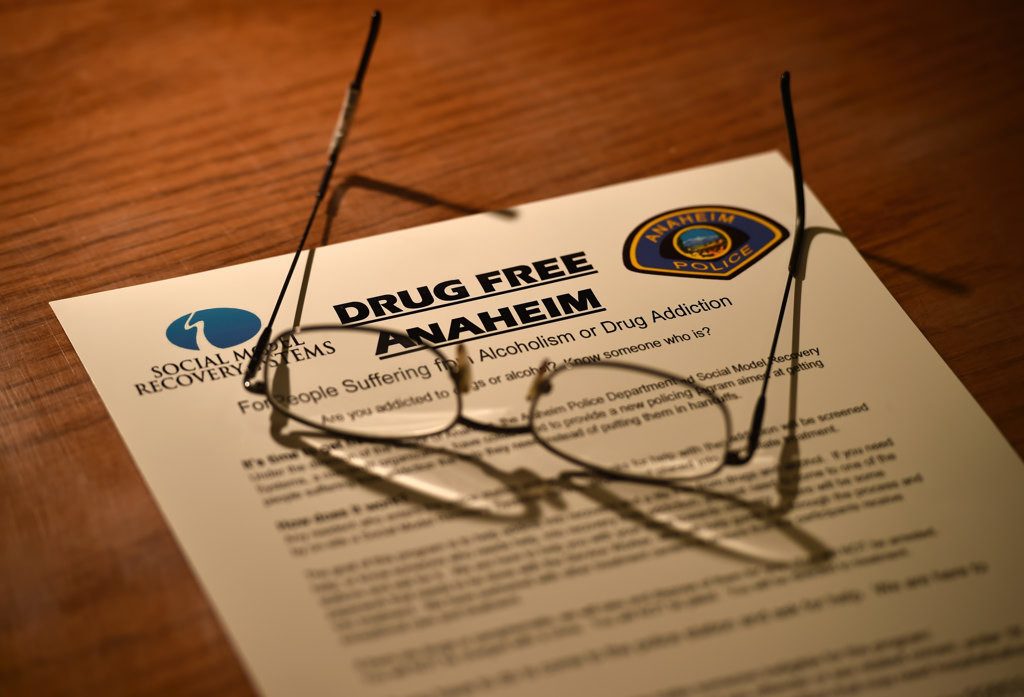The woman was desperate.
Det. Randy Adams could hear it in her voice.
Her daughter was hooked on heroin, and the woman worried that unless she got help soon, her daughter would soon be dead.
It was the kind of call Adams has received several times over the years – and the type of call that’s come more often as opioids have become the most notorious drug of abuse nationally and in Orange County.
A report from the Orange County Health Care Agency found that 70 percent of all drug overdoses investigated by the Coroner from 2011 to 2013 involved Opioids.
Nationally, more than six of 10 overdose deaths involve opioids, according to Centers for Disease Control and Prevention, and the number of overdose deaths involving opioids has quadrupled since 1999.
Anaheim is taking a proactive approach to the problem – Drug Free Anaheim.

A flyer about the Anaheim PD’s new program to help addicts. Photo by Steven Georges/Behind the Badge OC
Under the program, anybody wanting help for a drug problem can contact the Anaheim PD, either by phone or in person, and the department will connect them with Social Model Recovery Systems, a Covina nonprofit offering a variety of treatment options for chemical dependency.
An addict can even walk into the station and turn in their drugs without fear of prosecution, Adams said.
“I like to say that we are the conduit,” Adams said. “There is a great need for us to help these people in the city of Anaheim and in Orange County.”
Over the roughly two months Drug Free Anaheim has been up and running, Adams, who oversees the program, has referred five individuals to Social Model Recovery Systems, including the daughter of the woman who reached out to the investigator for help.
The program, believed to be the first of its kind on the West Coast, is modeled after a program started by the police chief in Gloucester, Mass. called the Police Assisted Addiction and Recovery Initiative.
According to its 2016 published annual report, PAARI provided help for 500 individuals and reduced crime by 27 percent since the program started in 2015.
When an individual reaches out to the Anaheim PD wanting help, Adams connects them with Collin Womer, screening and assessment coordinator with Social Model Recovery Systems, who will typically meet them face to face at the police station.

Mike Schaub, senior director of community relations for Social Model Recovery Systems, left, with Colin Womer, screening and assessment coordinator for Social Model Recovery Systems, worked with the Anaheim PD on the agency’s new Drug Free Anaheim program. Photo by Steven Georges/Behind the Badge OC
Based on what he learns about an individual’s history of drug use, mental health issues and legal history, Womer can recommend the appropriate course of treatment.
“I start to get a feel for what’s worked in the past perhaps and what hasn’t, so I can kind of recommend the programs,” Womer said. “We’re getting people that have been out there too long and getting beat up by the disease (of addiction).”
Under the umbrella of Social Model Recovery Systems are 14 different treatment facilities offering specialized programs for men, women, women with children, pregnant women and adolescents.
Individuals wanting help should be aware of some conditions to Drug Free Anaheim, Adams said.
For starters, the program must be voluntary; an addict reaching out for help should be doing so of his or her own volition, Adams said.
Individuals wanting help also should be free of arrest warrants.
“Everyone makes mistakes,” Adams said. “We get that. Often imes, people who have addictions are going to have warrants. We understand that, but we are still a police organization. If you’ve got warrants for your arrest, we are mandated by law to take you to jail.”
And if you’re wanting help, don’t walk into the police station severely under the influence of drugs, he said.
If that happens, chances are you’ll will spend some time in the city’s jail before discussions of treatment even occur, Adams said.
Anaheim Mayor Tom Tait, in his 2016 State of the City address, first spoke about plans to launch Drug Free Anaheim.
In his 2017 State of the City address in February, Tait announced the program’s successful launch.
“The number of people with serious drug and alcohol addiction in all walks of life is growing by the day,” the mayor said. “It’s approaching epidemic proportions, and all cities in America must respond.”
Drug Free Anaheim is still in its infancy, so its long-term success is impossible to gauge, Adams said.
But the investigator already has taken calls from other police agencies asking how the program is going.
“If we’re successful at it, it’s going to spread,” he said. “It should be successful. It really should be.”
 Behind the Badge
Behind the Badge



